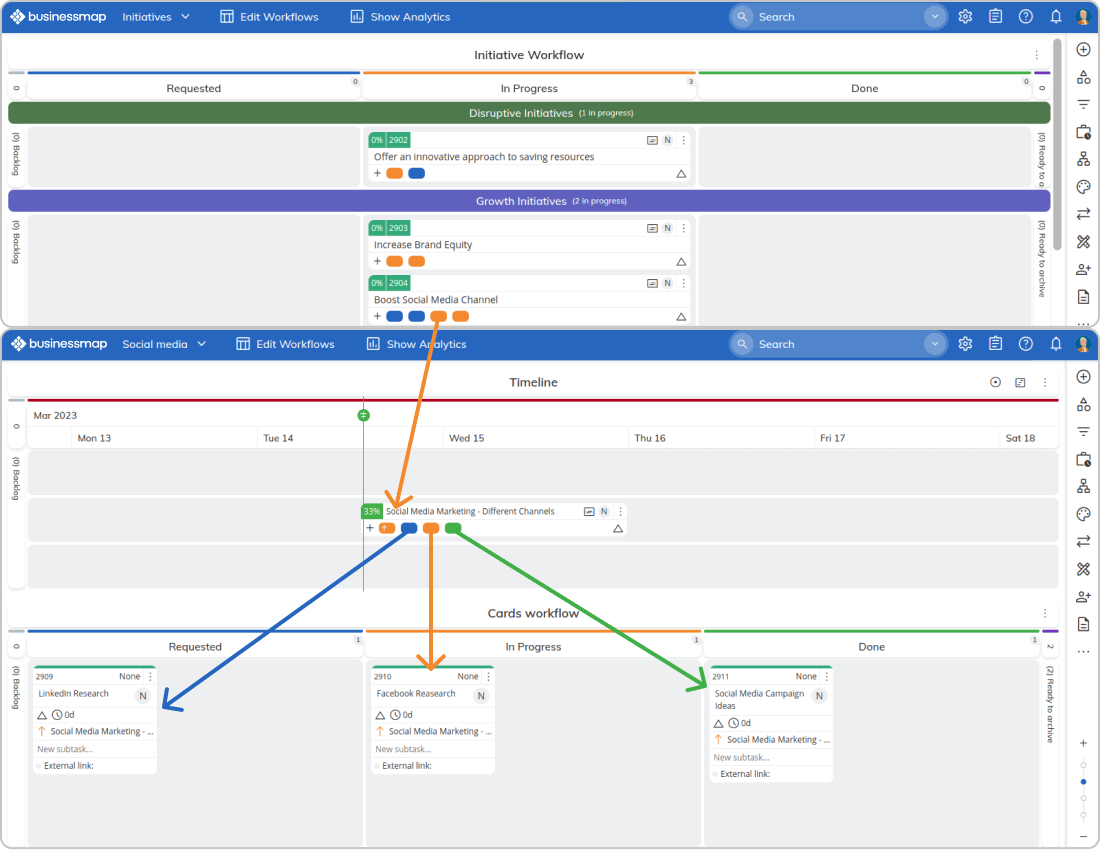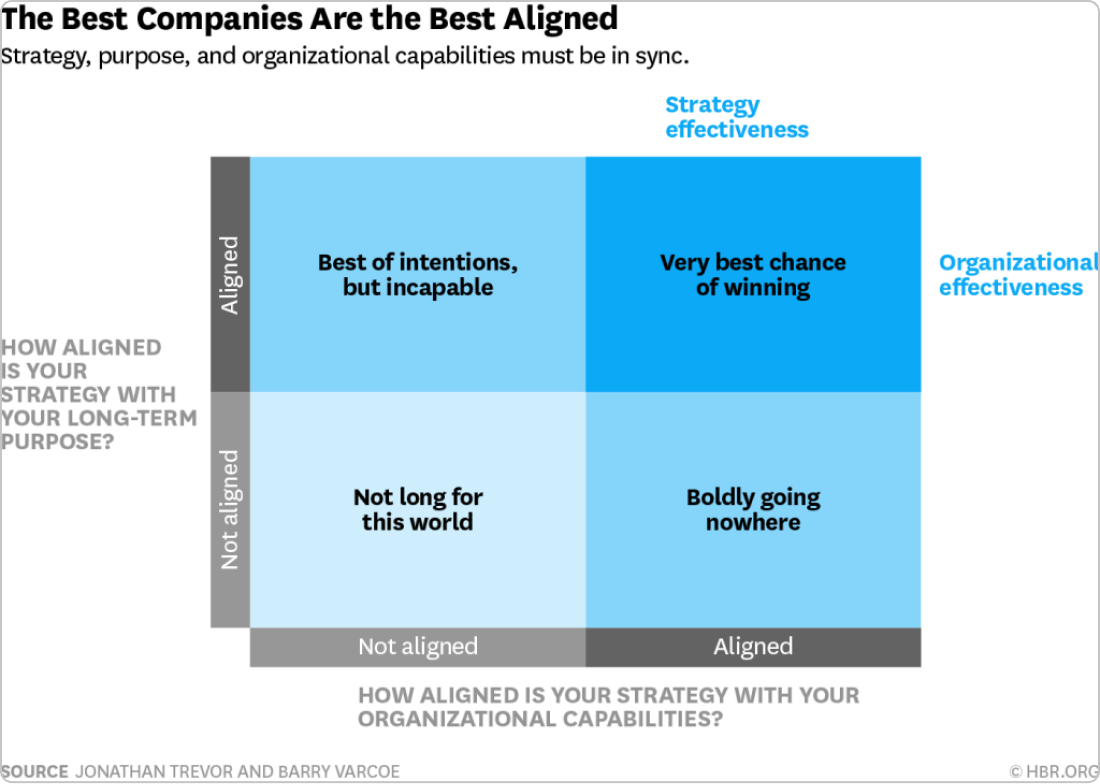Did you know that a staggering 90% of organizations struggle to bridge the gap between strategy and delivery due to poor implementation of their strategic goals? This highlights the critical significance of strategic alignment. So, let's delve into what it entails.
But first, let’s take a quick lesson to define what a strategy is once and forever.
Strategy Is ... but It Is Not ...
“Strategy is about competing to be unique” - Michael Porter
Strategy is a set of choices, decisions, and a holistic approach that an organization makes to position itself in the industry segment of its choice. It is about defining how the company will set itself apart from its competitors and how to effectively use its resources to deliver superior customer value and gain competitive advantage.
Strategy involves both long-term direction and short-term actions, considering internal capabilities and external market dynamics that affect the company's performance.
Ultimately, successful strategies are adaptive, coherent, and rooted in a deep understanding of the business environment, customer needs, and competitive landscape. For a strategy to be effective, its various elements need to work together seamlessly for long-term success. This means that the strategy needs to be well communicated across all levels of the organization so that everyone's efforts and actions can be aligned with the shared purpose.
Before moving forward, keep in mind these common misconceptions about what strategy really is.
-
The strategy is solely for executives. While upper management proposes the strategy and sets its direction, an effective strategy requires buy-in from all levels across the organization.
-
A strategy is a goal. Strategy is a holistic view of how a company will achieve a given goal.
-
Winning over the competition. While being competitive is important, strategy isn't just about beating rivals. It's about creating a unique value proposition for your target customer segment.
-
A strategy is a plan, and a plan is a strategy.
-
Strategy is about being the best. A good strategy focuses on what you will do and, importantly, what you won't do. It is about making trade-offs to meet the needs of your target customer, not all customers.
Now, let’s get into the essence of this article and discuss strategic alignment and how to ensure it in an organization.
Strategic Alignment Definition.
Strategic alignment is the process of ensuring that all aspects of an organization, including its goals, resources, and activities, are coordinated and in harmony with its overall strategy. It involves aligning departments, teams, processes, and systems to work cohesively toward the same strategic vision. It also entails creating a strategic roadmap of the organizational goals that align with what's most important for the company.
Strategic alignment ensures focused efforts on achieving strategy execution by prioritizing projects, allocating resources effectively, and improving agility to adapt to market shifts, technological advancements, and customer demands. It empowers timely adjustments to strategy and operations.
In short, strategic alignment is about making sure that every part of your organization is pulling in the same direction and working together to achieve the desired outcomes.
The Importance of Strategic Alignment.
Strategic alignment brings many advantages to organizations, making it critical for long-term success.
-
Increased Project Success and Performance. Strategic alignment facilitates greater efficiency and effectiveness across the organization. By aligning resources, processes, and activities with strategic objectives, organizations can consistently optimize performance and achieve desired results. According to PMI, aligned projects have a 57% higher likelihood of achieving organizational goals, underscoring the importance of strategic alignment.
-
Enhanced Focus and Prioritization. Alignment ensures everyone is working towards the same goals. This eliminates wasted effort on irrelevant activities and streamlines decision-making, allowing for better resource allocation. In fact, strategically aligned projects are 50% more likely to finish on time and within budget.
-
Stronger Customer Focus. Strategic alignment ensures that all departments are dedicated to delivering value to the customers. This fosters a customer-centric culture that not only improves satisfaction but also builds loyalty, making the customers feel valued and important.
-
Improved Agility. Strategic alignment equips teams to adapt quickly to changing market conditions. With everyone on the same page, they can make adjustments more efficiently, enabling them to seize new opportunities and mitigate risks, and making them feel more adaptable and responsive.
-
Better Employee Engagement and Satisfaction. When employees understand how their work contributes to the organization's strategic objectives, they feel a sense of purpose and fulfillment. Strategic alignment promotes employee engagement, satisfaction, and retention by creating a clear line of sight between individual contributions and organizational success.
How to Ensure Strategic Alignment?
To maintain strategic alignment, all aspects of the organization, including people, culture, structure, and process, have to be adaptable and synchronize with the strategy whenever it changes.
The following steps can guide you toward establishing an efficient strategic alignment in your organization.
Step 1: Create Transparency in the Organizational Structure
Don’t let decisions be made in isolation. Instead, create an organization with an interconnected network of empowered teams that encourage open communication and feedback loops in all directions. This organizational structure allows business functions to collaborate actively and provide strategy input.
Creating a transparent visualization of how strategic initiatives, team initiatives, and actions interconnect enhances the understanding of each contribution to the overall strategy, promoting alignment and shared understanding across the organization.
 Visualization of the connection between strategic initiatives and team projects on a portfolio board in Businessmap
Visualization of the connection between strategic initiatives and team projects on a portfolio board in Businessmap
Step 2: Communicate the Strategy
Don't let the strategy sit on a shelf. Once you develop a vision statement that outlines the organization's desired future state, communicate the strategic goals that cascade down from the vision. This will ensure that everyone understands the big picture and the direction in which the organization is headed.
Step 3: Choose a Goal-Setting Framework
Choosing a goal-setting framework helps translate your strategy into meaningful strategic goals with measurable results. It guides employees toward what the company wants to accomplish and tracks the progress of each initiative toward the goals.
Here in Businessmap, for example, we use OKRs to set and define our goals and translate them into tangible outcomes. It allows us to keep an eye on goals across the organization and see what’s progressing or falling behind.
 A dedicated OKR tracking tool provides insights into your progress toward accomplishing your objectives.
A dedicated OKR tracking tool provides insights into your progress toward accomplishing your objectives.
How Two of The Largest Organizations in the World Save Time & Money with OKRs?
Step 4: Cascade Strategic Goals into More Measurable Objectives
The strategy should inform everyone what objectives to set and what project priorities to define to execute your goals. To align your strategy and actionable objectives, there needs to be a clear breakdown of the objectives and a link between strategic goals and company/team objectives. Each department or team should have its own set of goals that contribute to the achievement of the overall organizational strategy.
 Visualizing the connection between strategy and execution
Visualizing the connection between strategy and execution
Step 5: Encourage Cross-Functional and Two-Way Communication
As mentioned before, the success of your strategy execution lies in a collective effort and contribution from all parts of the organization. Thus, as a leader, make sure to break down silos and promote an environment of transparent communication and sharing of expertise. Individuals should feel comfortable asking questions and sharing their ideas fearlessly and without hesitation.
Creating a cross-functional communication environment ensures that individual contributors and teams from different departments come together to support the execution of the set business priority goals. More alignment across function areas leads to better work performance, increased employee productivity, and an increased success rate.
In addition to strengthening the connection within the organization, regular feedback loops should be established to discuss employee performance and find new ways to excel in their performance.
Step 6: Performance Measurement and Progress Tracking
Monitoring and re-evaluating the execution of every project or portfolio is important to ensure that all work remains aligned and on track to achieve the strategic goals. Various key performance indicators (KPIs) and Lean/ Agile metrics help leaders and teams effectively track progress, identify areas for improvement, and make adjustments as needed to stay on course.
Another practical method of monitoring progress is conducting review meetings at various levels. This flow not only provides managers with insights but also equips them to make informed decisions about how best to adapt and adjust to the dynamic business environment. This, in turn, helps teams stay aligned on the most important priorities that drive the company forward.
How Systems Thinking Improves Successful Strategic Execution and Alignment?
Systems thinking can support strategic alignment by enabling a holistic understanding of the organization and guiding decisions to optimize the overall system's performance. Let’s dig deeper.
Systems thinking recognizes that various components and subsystems within an organization are interconnected and influence one another. Strategic alignment, on the other hand, emphasizes the need for all aspects of the organization to work cohesively toward a common strategy.
When applying systems thinking, organizations consider how different parts of the system interact and impact each other. This perspective helps in understanding the dependencies and relationships between different services, functions, teams, and processes within the organization. It allows for a deeper understanding of how strategic decisions and changes in one area can affect other parts of the system.
Strategic alignment, on the other hand, involves aligning goals, objectives, resources, processes, and activities to support the overall strategy. It acknowledges the connections of different parts of the organization and emphasizes the need for coordination and collaboration to achieve strategic goals.
A systems thinking approach not only enhances organizations' capacity to identify and optimize interconnections between services but also fosters global improvements rather than isolated changes. Furthermore, it facilitates the flow of information across all services, enabling strategic alignment and fostering a shared understanding of the organizational strategy.
Strategic Alignment Assessment Approach
“Is my company really aligned?”
To answer this question, you can use various techniques, strategy execution tools, and frameworks to assess your strategic alignment. They provide a practical approach to assessing the alignment between an organization's strategy and its day-to-day operations.
To showcase how this works, we take as an example the matrix provided by Harvard Business Review.
In brief, two key questions are posed to help assess alignment:
1. How well does your business strategy support your company’s purpose?
2. How well does your organization support the achievement of your business strategy?
By answering these questions honestly and objectively, leaders can identify areas of misalignment and take corrective actions to ensure that the organization is effectively executing its strategy.
The four possible outcomes are plotted on the matrix below.
 Image Credit: Harvard Business Review
Image Credit: Harvard Business Review
Each quadrant tells us the following:
-
Best intentions, but incapable - These companies are said to have a clear purpose and a well-defined strategy but lack the organizational structure to execute the strategy.
-
Very best chance of winning - These companies are said to have a clear purpose, a well-defined strategy, and an organizational structure that effectively executes the strategy.
-
Not long for this world - These companies are said to have a weak sense of purpose, a poorly defined strategy, and an organizational structure that cannot execute the strategy.
-
Boldly going nowhere - These companies are said to have a strong organizational structure but a weak sense of purpose.
Businessmap is the most flexible software
to align work with company goals
In Summary
Strategic alignment is the process of synchronizing an organization's objectives, resources, and operations, achieved through goal alignment, resource allocation, and process coordination. It enables companies to focus their efforts, resources, and talents toward shared purpose and goals. Aligned companies are more likely to show better project results, improved performance, and a sustainable competitive advantage.





 Visualization of the connection between strategic initiatives and team projects on a portfolio board in Businessmap
Visualization of the connection between strategic initiatives and team projects on a portfolio board in Businessmap
 Visualizing the connection between strategy and execution
Visualizing the connection between strategy and execution Image Credit: Harvard Business Review
Image Credit: Harvard Business Review 


